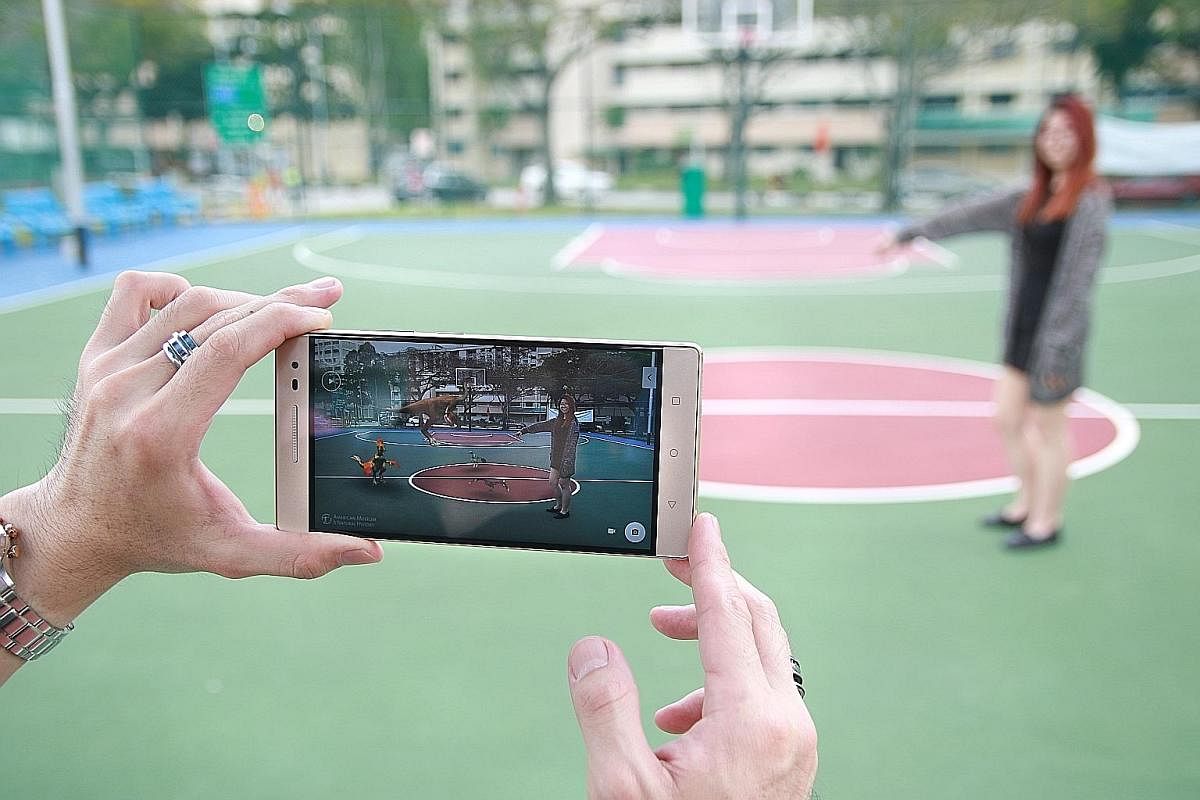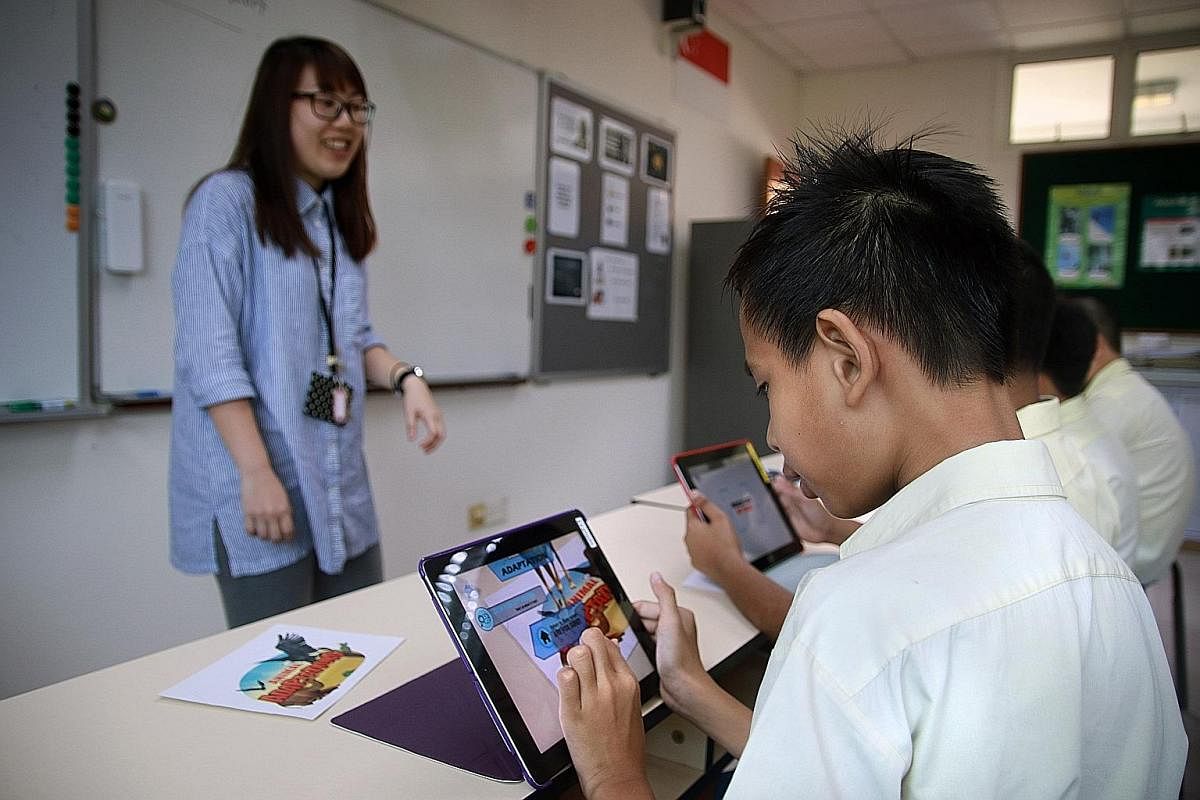Augmented Reality in the classroom: Move over, Pokemon Go, it’s time for science class
Augmented reality, the technology used in the mobile game, is now being used in education and design, among other things


At Metta School in Simei, nine pupils attend an unusual science lesson with a twist.
They use augmented reality to learn about animal adaptations - features such as a camel's hump and its long eyelashes that help it survive - and are drawn in by the animation and sound effects.
The school has been using augmented reality in some science classes since last June and the new feature has sparked interest in the subject and helps pupils concentrate, says their science teacher, Ms Laura Lim, 27.
Augmented reality, which superimposes computer-generated information onto a user's view of the real world, does more than just allow users to picture themselves with cute Pokemon Go characters or place rabbit ears on their head via Snapchat.
Recently, the technology has surfaced in areas such as education and design, and has been used in museums, proving that there are practical applications too.
At least two primary schools - Chongzheng and First Toa Payoh - have also been using an augmented reality app by virtual and augmented reality provider Eon Reality in some of their science classes.
Montfort Junior School also plans to conduct visual arts classes that introduce its Primary 2 pupils to augmented reality, in the second half of the year. These classes, which are co-designed with local technology start-up Immersively, will teach pupils to use augmented reality technology in art creation.
The school's aesthetics co-ordinator, Mrs Cassandra Ng, 45, says: "Pupils nowadays are exposed to technology from a young age. We want to engage them through platforms such as augmented reality and help them be competent and knowledgeable in this area.
"We also want to spark creativity in them and help them make connections between such technology and what they are learning in school."
Adults, too, are enjoying the developments in augmented reality technology.
A new smartphone, launched last month, boasts several new augmented reality features made possible through Tango, an augmented reality technology platform developed by Google. It has, among other things, depth-sensing and motion-tracking capabilities.
Users of the Lenovo Phab 2 Pro, the first Tango-enabled smartphone, can download an app called Measure, which allows them to point their phone cameras at an object to estimate its length, width, height and volume.
The measurements are displayed in augmented reality and seen on the screen of the phone.
Another downloadable app, Dinosaurs Among Us, created in partnership with the American Museum of Natural History, enables users to see virtual life-sized models of four dinosaurs - the archaeopteryx, velociraptor, caudipteryx and ornithomimus - anywhere, perched on the kitchen table or at a nearby basketball court.
Click on each reptile and description boxes pop up with interesting facts.
Sales of the new phone have been encouraging.
Mr Khoo Hung Chuan, 48, Lenovo's cluster general manager for Malaysia and Singapore, says: "As the augmented and virtual reality ecosystem grows, the variety of these devices and experiences will drive the explosion and adoption of such technology into mainstream markets. We believe that there's room for both augmented and virtual reality smartphones and other technologies such as headsets."
Museums are also turning to augmented reality in a big way. The Indian Heritage Centre incorporated augmented reality in its permanent galleries in 2015, allowing visitors to listen to a virtual personal guide.
The ArtScience Museum followed suit last month, with an exhibition that uses augmented reality to take visitors through a Sumatran rainforest.
The Trick Eye Museum in Sentosa is also expected to introduce augmented reality features in its exhibits in the coming months.
Associate Professor of Law Eugene Tan, who co-teaches an inter-disciplinary course on emerging technology at Singapore Management University, says: "As we aspire to be a Smart Nation, there is no doubt that augmented reality will be increasingly common and used in a variety of sectors ranging from education and eldercare to healthcare and marketing."
But experts and industry players say the development of such technology, while promising, is not without its challenges.
Mr Sahil Kumar, 26, business development manager at Eon Reality, adds: "A lot of attention and time is needed to create augmented reality simulations. Our apps are conceptualised with teachers and iterated multiple times to achieve the desired learning outcome."
Associate Professor of Information Technology and Operations Management Damien Joseph at Nanyang Business School says: "The cost of implementation is still a challenge. Organisations also need to assess how and why augmented reality adds value to their services.
According to Mr Y.T. Ho, 52, director of local technology company Dante Technologies, the cost required to create augmented reality products can range from US$30,000 (S$42,000) to more than US$500,000, depending on the complexity of the effects.
But when done right, for example in schools, augmented reality can make classes come alive.
Metta School student Nabil Qusyairi Adi Hasri, 11, who used augmented reality to view a virtual camel on an iPad during his science class last Thursday, says: "I feel like I am playing a computer game.
"The camel looks like it is in the real world - so fun!"
Correction note: An earlier version of the story said that Riverside Primary School has been using an augmented reality app in some of their science classes. This is incorrect. The school does not use such an app for its science classes.
Join ST's Telegram channel and get the latest breaking news delivered to you.
A version of this article appeared in the print edition of The Sunday Times on March 26, 2017, with the headline Augmented Reality in the classroom: Move over, Pokemon Go, it’s time for science class. Subscribe

